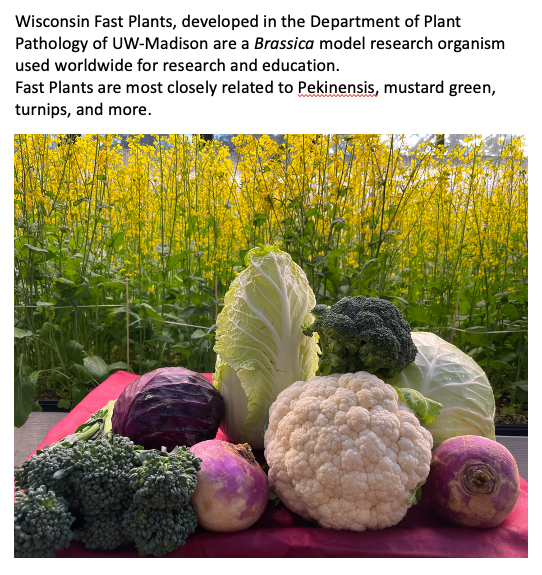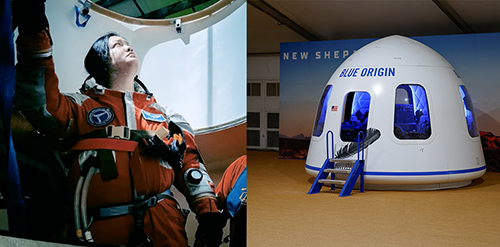Fast Plants in Space: Next Steps with Amanda Nguyen & Emily Calandrelli
Long-term space exploration depends on many factors, and plant research in space is one of the most pressing. For decades, Wisconsin Fast Plants have helped scientists and educators explore biological mysteries, and now, they’ve returned to orbit, contributing to plant research in space.
Blue Origin’s Fall 2024 mission (NS-28) included STEM educator and science communicator Emily Calandrelli and two Fast Plants experiments.
Now, Fast Plants will return to space on another Blue Origin mission—this time with astronaut and STEM advocate Amanda Nguyen. This mission will build on Calandrelli’s experiments by studying seedlings grown from seeds produced by plants that were exposed to microgravity during her flight.
Our work with these astronauts is designed to engage educators and students in real-world research. This builds on past collaborations, such as the 1997 CUE-TSIPS project (STS-87), when U.S. and Ukrainian students grew Fast Plants in classrooms alongside space experiments on Columbia (Shout-out to Paul Williams, “Father of Fast Plants” and his wife Coe for this foundational work!). Similarly, our Wisconsin Fast Plants team at the UW-Madison Department of Plant Pathology donated seeds to both Calandrelli and Nguyen’s missions for distribution to educators. These space-flown seeds will allow teachers and students to conduct hands-on experiments and explore how plants grow in different environments. (Learn more about how to get space seeds and free lesson plans at NSTA 2025 here.)
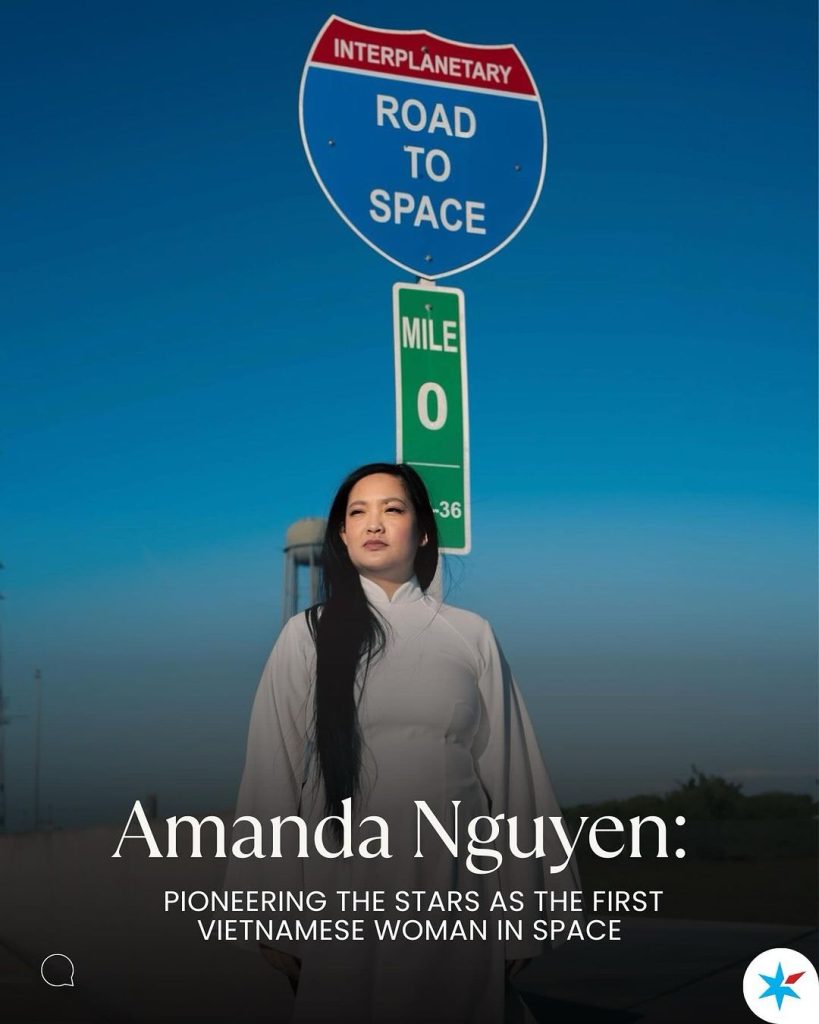
Expanding Our Research in Microgravity
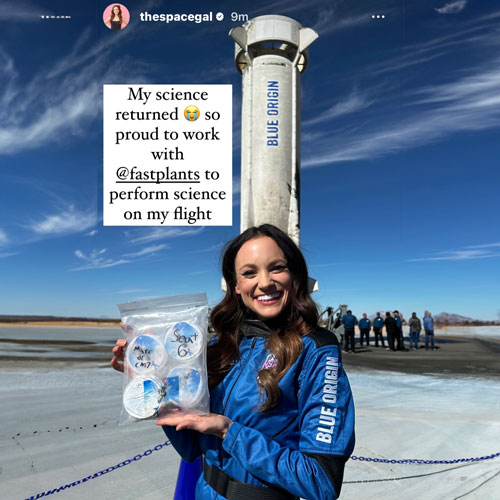
Plants will be essential for future space missions—as food, for oxygen production & water recycling, and for astronauts’ well-being. So, it’s critical for plant research in space to continue probing how plants grow and function in microgravity.
On the 2024 Blue Origin mission, Emily Calandrelli worked with Fast Plants to study how early exposure to microgravity might impact nutrient uptake. The results were inconclusive–as is the way with most scientific experiments–and raised further questions and curiosity.
Now, Amanda Nguyen’s 2025 mission will take this research further. She will transport seedlings grown from seeds flown in space by Calandrelli, implementing revised experimental procedures. We are currently refining the procedures, based on the nutrient data gathered from our Calandrelli experiments. This type of iterative experimentation is at the heart of science, and it motivates us!
Refining Light & Dark Experiments
Light plays a crucial role in plant growth, yet in space, where “up” and “down” disappear, how do plants orient themselves and adapt their photosynthetic processes?
In addition to our 2024 nutrition uptake experiments, Calandrelli conducted light and dark experiments to explore seedlings responses in microgravity. Nguyen’s mission will replicate and expand these experiments, further exploring how students can test in classrooms how plants respond to space-like conditions.
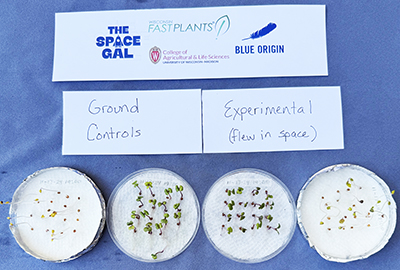
For educators, this research presents an exciting opportunity: students can conduct similar experiments in the classroom, directly connecting their learning to real-world space biology.
Bringing Space Science to Classrooms
Fast Plants space research is and always has been grounded in education. Emily Calandrelli and Amanda Nguyen are both dedicated to STEM outreach. Their work ensures that students worldwide can engage with space science firsthand.
Nguyen, whose heritage connects her to Vietnam, is also collaborating with the Vietnam National Space Center. She will bring her space-flown Fast Plants seeds back to Vietnam to share with educators and students there. By growing and learning with these seeds, students gain hands-on context for discussing sustainable agriculture, space exploration, and STEM careers. In this way, space science can inspire the next generation of innovators, no matter where they are in the world.
Join Us at NSTA 2025: Hands-On Learning with Space-Flown Seeds
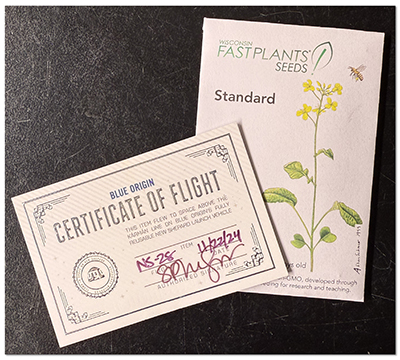
Are you going to the 2025 Spring NSTA conference in Philadelphia? If so, you can bring space-seeds and Fast Plants lessons to your classroom by joining our Wisconsin Fast Plants workshops! Emily Calandrelli’s 2024 space experiments will be featured, giving an inside look at how Fast Plants are used as a model organism in plant research in space.
- Every participant will receive a free packet of Fast Plants seeds that flew on Blue Origin with Calandrelli, allowing students to grow and study real space-exposed seeds!
This is a one-of-a-kind opportunity to connect students with authentic space research and bring STEM learning to life. We’ll have two workshops, both in Carolina Biological‘s workshop room (Pennsylvania Convention Center – 109 B). Seating is limited; so, plan ahead, and join us!
- Thursday, March 27 • 2:20 PM – 3:20 PM
- Friday, March 28 • 1:20 PM – 2:20 PM
Follow the Mission & Access Resources
Stay updated on Nguyen’s Blue Origin mission and other plant research in space collaborations by following @fastplants on social media. Download lesson plans, follow blog posts, and bring space research into your classroom!
Whether you’re growing space-flown Fast Plants in your classroom or conducting experiments with Earth-grown Fast Plants seeds, you’re part of this journey! Together, we’re planting the seeds for the future—on Earth, in space, and beyond. 🚀🌱
